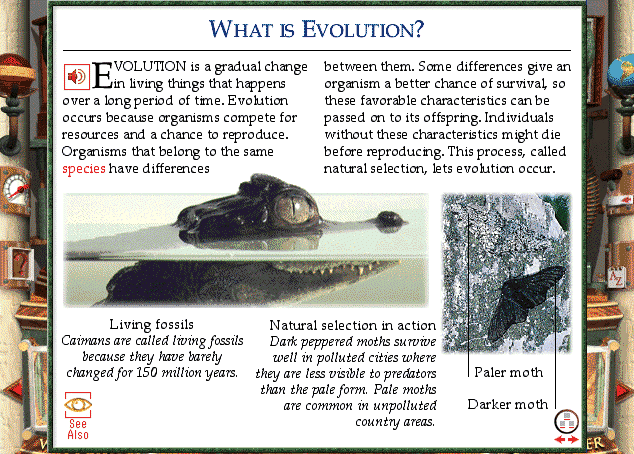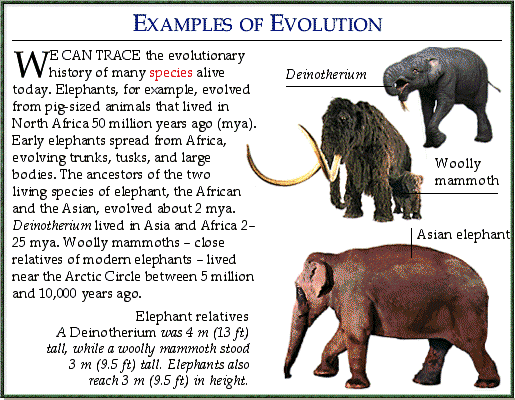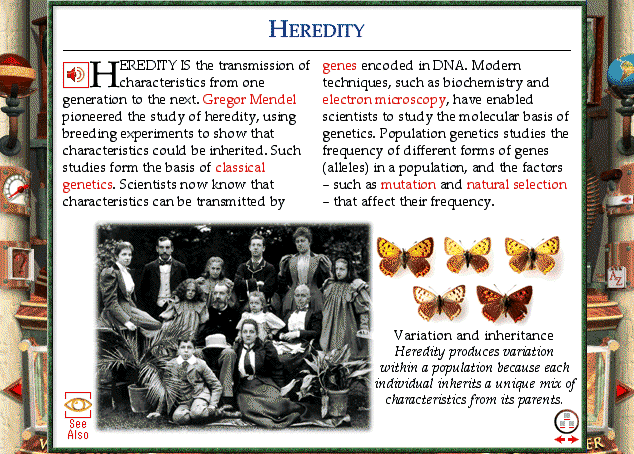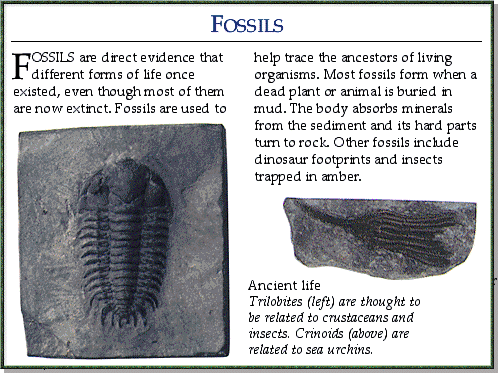
Nature |



How Life Began
Geological evidence suggests that life has existed on Earth for about
4 billion years of its 4.6-billion- year history - but how it began is a
subject of great speculation. Most scientists believe the first life forms
were probably self-replicating molecules, similar to DNA, that formed by
chance early in the planet's history.
The Primitive Earth
Rocks from the Moon brought back for analysis by the Apollo astronauts, as
well as observations of the cratered surfaces of other planets, show that
the Solar System underwent an intense bombardment by meteorites between 4.1
and 3.9 billion years ago. This would have melted the Earth's surface, making
it impossible for life to exist. But when the bombardment ceased it did not
take long for life to gain a foothold.
Paleontologists have discovered accumulations of single-celled organisms,
called cyanobacteria, in rocks formed only 200-400 million years after the
bombardment era, and there is even evidence of biological molecules in the
oldest known sedimentary rocks on the planet.
The primitive Earth was an inhospitable place. Its atmosphere consisted chiefly
of hydrogen and other gases that today we regard as poisonous. There was
widespread volcanic and earthquake activity, as well as gigantic electrical
storms. The Sun was brighter than it is today, and its harsh ultraviolet
radiation reached the planet's surface, which is now protected by ozone in
the upper atmosphere. There were no oceans - only small pools of murky rainwater,
cloudy with volcanic
ash.
The First Replicators
Most scientists believe that life began among the chemical reactions
taking place on the young planet. Life probably arose from the increasingly
complex chemicals that formed as simple compounds reacted together. The key
event was the appearance of a molecule that could make copies of itself or
self-replicate. In doing so it demonstrated one of the fundamental properties
of life: the ability to reproduce.
In the Earth's early days, lightning and ultraviolet light from the Sun broke
apart the simple, hydrogen-rich molecules of the primitive atmosphere. When
this happened, the fragments recombined spontaneously to make larger and
more complicated molecules. This process is thought to have produced a soup
of increasingly complex molecules in lakes and oceans until, quite by accident
one molecule appeared that was able to replicate, using the other molecules
in the soup as its building blocks. This molecule was the earliest ancestor
of DNA. All life on Earth today depends on the ability of DNA (or the related
molecule RNA) to store information and replicate. The DNA and RNA in every
living creature, from a virus to a whale, is thought to be descended from
one of the first self-replicating molecules that appeared on the planet.
Scientists believe the first replicator was probably not a DNA molecule,
because DNA cannot copy itself without using proteins, and proteins cannot
be produced without using DNA. This chicken- and-egg situation has led some
to suggest that the first replicator was an RNA molecule, which can replicate
like DNA, but which can also act as an enzyme, like proteins. It is also
possible that the first replicator was something quite different from DNA
and RNA that no longer exists.
The emergence of a replicating molecule represented the beginning of biological
evolution. As the population of replicators grew, some were damaged by chemicals
or by radiation from the Sun. In most cases these would have "died" but some
were subtly changed, resulting in new types of replicators. Some of the variants
would have been better at copying themselves, and would have become more
common. Others learned to cooperate with one another, forming complex
colonies of molecules. Over time, these colonies are thought to have evolved
into the first microorganisms.
The Stanley Miller Experiment
In 1953 the US chemist Stanley Miller (born 1930) performed a historic
experiment to demonstrate how organic chemicals could have appeared spontaneously
on Earth. In a glass jar he mixed the chemicals thought to have been in the
Earth's atmosphere: hydrogen, methane, ammonia, water vapor, and liquid water.
He then simulated lightning by generating an electrical discharge in the
jar. After several days the mixture changed color. Upon analysis it was shown
to contain some of the amino acids that are common in proteins today. Later
experiments involving a slightly different mixture of chemicals produced
some of the building blocks of DNA and RNA.
While these experiments show how simple organic compounds could have originated,
the huge step to the appearance of a replicator remains a mystery to
science.
Where Did Life Begin?
Research carried out since the classic Miller experiment suggests that
large, complex organic molecules would be unlikely to form in a soup. A more
likely site might have been the surface of rocks. There is some evidence
that amino acids splashed onto clay surfaces from pools can combine to form
long chain molecules. Scientists have called this the "primordial pizza'
model for the origin of life, as it would have taken place in many small
areas scattered over various types of rocks.
It is unlikely that life began on land, where conditions would have been
harsh. Intense radiation from the Sun, for example, would have destroyed
complex molecules as quickly as they formed. Some scientists believe that
life began in vents of hot water on the ocean floor, where the key chemicals
and energy would have been present and where the complex organic compounds
would have been protected from the Sun.
Cells and Beyond
The first replicators were not nearly as complex as modern single-celled
organisms, which are highly sophisticated forms of life. The smallest living
things known today are minute viruses made of less than 10,000 atoms. These
are so simple that some scientists do not classify them as living. They are
thought to have evolved from fragments of more complex organisms, rather
than from simpler organisms.
Scientists believe that the first cells may have been fat droplets in which
organic compounds became concentrated, and in which the first replicators
may have formed. Another theory is that tiny spheres formed from proteins
in the organic soup, and replicators formed inside these. Other scientists
believe that the first replicators were free-floating "naked genes" and that
cells evolved later.
The first life forms were heterotrophs - organisms that obtain food from
their surrounding. As the population of heterotrophs grew in number, they
would have exhausted the supply of organic materials in their environment.
Some variants might have overcome this by becoming predatory, evolving the
ability to destroy and assimilate their rivals. Others evolved the ability
to synthesize their own nutrients using energy (perhaps from the Sun) and
inorganic chemicals in the environment. These were the first autotrophs,
and they eventually evolved into the cyanobacteria - primitive bacteria that
make food autotropically by photosynthesis. The cyanobacteria, which still
exist today, made the oldest known fossils on Earth - 3.8-billion-year-old
mineral deposits called stromatolites.
An important episode in the evolution of life was the evolution of sex, which
seems to have emerged about two billion years ago. Before then, new types
of microorganisms could only arise as a result of mutations, which meant
that evolution was very slow. However, sex allowed organisms to exchange
genes and combine them in new ways, which increased the rate of evolution
dramatically.
All life on Earth can be traced back to the first self-replicating molecules
- perhaps to a single molecule - assembled by chance when the planet was
young. They arose with astonishing speed, perhaps only a few tens of millions
of years after the surface of the Earth cooled down. Inside all our cells
are their direct descendants.
The Theory of Evolution made easy Evolution has no teleology
The Fossil Fallacy - Michael Shermer - Why missing links
don't invalidate
evolution.
Just a Theory - Scientific American - why dismissing
evolution as just a theory is a misunderstanding.